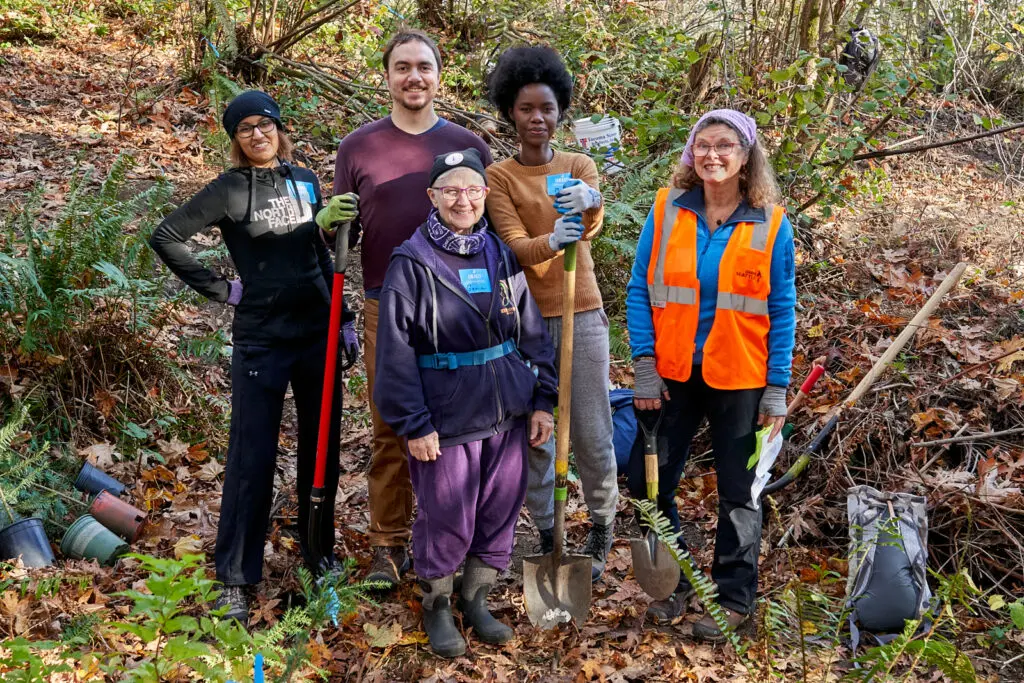This is the sixth of a blog series highlighting Forterra’s history in anticipation of the organization’s rapidly approaching 35th anniversary. This is the start of a year of looking back to look forward, a concept honoring the Sankofa symbol of Ghana’s Akan Tribe which means we should not be afraid to look to our past to help plan our future. This Forterra history project delves into the people, cultures and changes and that shaped the region and the organization and includes historical anecdotes, interviews with visionaries, perspective pieces from a diverse range of experts and celebrates the learning-est moments in Forterra’s history from 1989 through yesterday evening.
Written by Kelsey Bray
In conservation work, the biggest projects often get the most attention – and for good reason. Acquiring large parcels of land for conservation can take years of hard work and collaboration from multiple organizations and the surrounding communities. But it’s worth the time to restore and steward places like the Teanaway Community Forest, Lake Serene Trail and Port Gamble Forest.
However, smaller projects – some that you might not even realize are being conserved – are just as essential. That’s the case with Amon Creek Natural Preserve. At the end of 2022, Forterra helped reunite the mineral rights of two parcels, about 72 acres, with the original title. It’s now complete, and the preserve is no longer at risk of incompatible use.
Amon Creek Natural Preserve
Amon Creek, which is located in the Southeastern Washington City of Richland, is the largest tributary of the lower Yakima River. It’s home to a mix of habitats, as well as plenty of wildlife – more than 150 bird species have been spotted there, according to The Tapteal Greenway.

In 2001, The Tapteal Greenway formed the Amon Basin Community Project to conserve the area. This volunteer-led organization worked with several partners to find available parcels and funding sources to acquire them. In 2007, they purchased 60 acres, followed by 15 the next year. These parcels were transferred to the City of Richland to become the Amon Creek Natural Preserve.
However, the title didn’t have mineral rights. When they are held in separate ownership from the land, the owner of the rights may disturb the land to explore for minerals at any time. The rights associated with Amon Creek Natural Preserve were donated to Forterra in 2012. To ensure conservation of the area, Forterra donated the rights to the City of Richland through a real estate conveyance that will ensure local stewardship of the natural open space.
“The citizens of Richland love the Amon Creek Natural Preserve, a unique mixture of wetland, riparian and shrub-steppe habitat providing home to birds, rabbits, coyote, raccoon, beaver and others,” said Richland City Attorney Heather Kintzley. “The preservation of this area was years in the making and accomplished by the diligent members of The Tapteal Greenway. The city is pleased to see the severed mineral interests formerly held by Forterra rejoined with the surface estate, which further bolsters the continued preservation of this unique and cherished area.”
What are mineral rights?
When someone sells a parcel of land, they may choose to retain certain rights, also known as interests, in the deed. That can be timber, water or grazing rights. These can be transferred independently from the surface estate.
In the case of Amon Creek, it was mineral rights like oil and gas. That includes the right to sell all of part of the interest, to enter the land and explore or drill, to lease them to someone else and to create fractional shares.
So, even if someone owns the land, the person with mineral rights can enter their property to extract the resources under the surface. That’s why reuniting them is so important. However, it’s not always easy to do.
Wild Sky Wilderness
In 2007, Forterra, then the Cascade Land Conservancy, began working on transferring 480 acres in the Mt. Baker-Snoqualmie National Forest to the U.S. Forest Service (USFS). The properties included long reaches of Wallace River, just above the extremely popular Wallace Falls. The river frontage features late-successional forest, high alpine rocky terrain and riparian habitat. It supports several species, including spotted owl and mountain goat.


The USFS needed clean and complete title to the property, so Forterra’s then Snohomish County Project Manager Joe Sambataro began tracking down mineral rights that hadn’t been used for half a century. The first step was searching public records at the Snohomish County Treasurer and Assessor’s Office.
He then had to search for the last known owners. The most recent record of their mineral rights ownership was 1951. After looking through titles, obituaries and wills, and then contacting six possible heirs, Sambataro eventually filed a claim of abandonment or extinguishment of mineral rights.
Once the private in-holdings were acquired, Forterra was able to transfer 480 acres to the USFS, which became part of the Wild Sky Wilderness area. It’s now conserved for public benefit forever.
Conservation is complex. It requires multiple areas of expertise, as well as cooperation from nonprofits, local governments, the community and more. But it’s all worth it for the end result – land that benefits people, wildlife and the ecosystem for generations to come.






